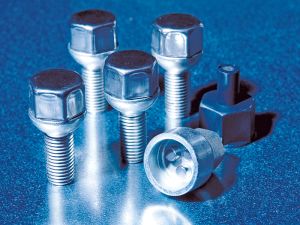The expensive and eye-catching alloy wheels and tyres fitted to all shapes and sizes of vehicles these days are a prime target for criminals. Or at least they would be if manufacturers and owners didn’t take steps to thwart thieves using locking wheel nuts or locking wheel bolts.
Many manufacturers fit locking wheel nuts as standard to new cars, and if your car doesn’t have them you can easily buy a set from your dealer, car accessory store or online retailers.
There are four locking wheel nuts in a set, and they come with a single matching ‘key’, which is a specially shaped socket designed to fit the supposedly unique pattern of your locking wheel nuts. In fact, there are a limited number of patterns used by individual manufacturers, so other drivers will have keys that match your wheel nuts too.
- SEE MORE Best cordless impact wrench
You only need to use one locking nut on each wheel, where it simply replaces one of the regular wheel nuts. Fitting locking wheel nuts is easy, and they provide an excellent deterrent against opportunistic theft. In fact, as a result of locking wheel nuts being widely fitted, car wheel theft has become pretty rare. However, the bad news is that wheel theft from premium cars could be on the rise again, in spite of widespread use of locking wheel nuts. That’s because, given the right equipment and a few minutes work, committed criminals can overcome most of the challenges the different types of locking wheel nuts present.

Alloy wheels are becoming ever more extravagant and expensive, and one of the factors influencing an increasing incidence of wheel theft could be Personal Contract Purchase (PCP) schemes. That’s because anyone who damages wheels on a car they’re driving on a PCP will find themselves liable for replacement costs that could run into thousands of pounds when they’re due to return their car. In which case, it’s easy to see how people might be tempted to ask no questions when offered a cheap ‘second hand’ wheel replacement via an internet ad.
Theft aside, as with most forms of security, problems often start for the locking wheel nut owner when you lose or damage the key. To make matters worse, you may not realise you’ve lost your wheel nut key until you need it - perhaps leaving you stranded at the side of the road with a punctured tyre on a wheel you can’t remove.
Fortunately locking wheel nut removal is relatively easy for breakdown services, professional tyre fitters and mechanics with the right equipment. You can also attempt DIY removal using locking wheel nut removal tools available to buy from accessory shops or online, but it’s easy to damage your expensive wheels or make the problem worse if you get it wrong.

Types of locking wheel nut
There are three main types of locking wheel nut, and the simplest and most popular is a keyed head on your wheel nut that requires a matching socket to undo it. Next are the type of locking wheel nuts with a rotating collar around the nut, designed to make it impossible to get purchase on the nut without the key. Finally, on cars that use removable wheel bolts instead of nuts, you find bolts with heads that are designed to shear off if you don’t have the proper removal key.
Locking wheel nut removal
If you’re stuck with a locking wheel nut and no key, the first thing you can do is order a new one. This is easy if you have the code - check your car’s handbook or document file - as with this you can simply order a replacement key from your local dealer.
If you can’t find the key all is not lost, because there are firms who will match your key pattern from a phone picture you send in showing the shape of your wheel nut. (Remember each wheel nut manufacturer has a limited number of patterns.) In this case you’ll often have to supply evidence that you own the vehicle you’re trying to get a wheel off, which could also mean sending a photo of your V5C log book.
How to remove a locking wheel nut without the key
There are DIY tools available to remove locking wheel nuts without a key, but using a locking wheel nut remover requires a certain amount of confidence and they don’t always work.
For example, Halfords sells a special socket designed with a reverse thread on the inside that bites into your wheel nut and grips it hard enough for you to undo it. Many people have used them successfully, but even Halfords advises the tool should be used with a compressed air hammer for best results, and most people don’t have that sort of equipment at home.

The other favoured option when dealing with a lost key or damaged locking wheel nut is to drill out the offending wheel nut. Again this can be done by a competent DIY-er with the right equipment, but most people find it far easier to get the job done by professional mechanics at the garage.
In that case, locking wheel nut removal costs are most likely charged at an hourly rate, and you might reasonably expect a bill of no more than half an hour’s labour per wheel.
Now your wheel nuts are sorted, check out our latest tyre test...
from Sitewide RSS feed https://ift.tt/3ylYf5z
No comments:
Post a Comment